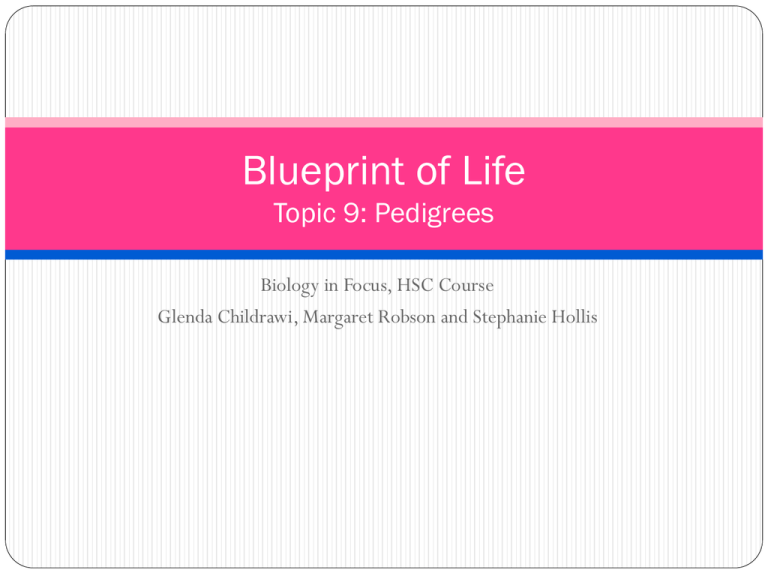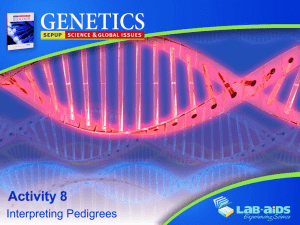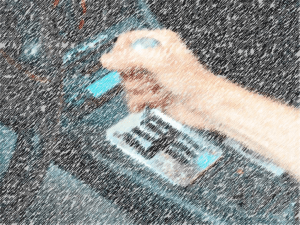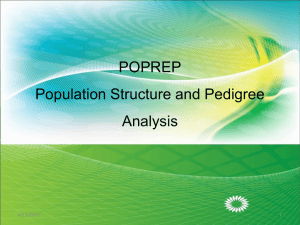9.1.1 Pedigrees - PrelimBio
advertisement

Blueprint of Life Topic 9: Pedigrees Biology in Focus, HSC Course Glenda Childrawi, Margaret Robson and Stephanie Hollis DOT POINT(s) perform an investigation to construct pedigrees or family trees, trace the inheritance of selected characteristics and discuss their current use Introduction In order to study inheritance patterns in humans, it would be ethically unacceptable to carry out controlled breeding or test crosses to determine their genotypes. A pedigree chart (biological family tree) is constructed, based on the phenotypes present in related individuals, and this is used to trace the inheritance of any particular characteristic. magazine.100percentrock.com Pedigrees These pedigree charts or diagrams are drawn up in a universally accepted scientific format, using standard symbols. They show an individual’s biological relatives and their partners as a series of circles and squares, linked by lines. The occurrence of a particular trait within the family is represented by shading. biobook.nerinxhs.org Pedigrees A pedigree can therefore be defined as a graphical representation of the inheritance patterns of a particular trait in related individuals over a number of generations. scisquadtmms.wikispaces.com Pedigrees Pedigree analysis is then done to determine: ■ how many family members have the disorder ■ the gender (male or female) of the affected individuals ■ how individuals are related ghr.nlm.nih.gov Pedigrees This information is used to: ■ determine inheritance patterns ■ assign genotypes to individuals where possible ■ make predictions about the risks of an individual inheriting a genetic disorder, abnormality or disease. www.yorku.ca Current Use of Pedigrees Pedigree charts allow easy scientific analysis of the inheritance of genetic traits within families and are useful for studying heredity patterns in humans and other animals. In humans, most pedigrees are analysed to identify and trace genetic disorders In animals, they are useful for selecting individuals with desirable traits for breeding purposes. www.nidcd.nih.gov Human Pedigrees By assigning genotypes to individuals and making predictions from pedigrees, human pedigrees may be used to: ■ determine if particular family traits are genetically inherited ■ trace the occurrence of a genetic disorder, abnormality or disease within a family over several generations ■ deduce genotypes: determine the probability that prospective parents are heterozygous for (and therefore carriers of) a particular defective allele ■ predict the likelihood of a family member inheriting a trait or developing a disorder. a Human Pedigrees This type of information is used by genetic counsellors to advise parents on minimising or avoiding the risks of producing a child with the defect. This pedigree information may also be used by researchers to develop a program to eliminate the inherited defect in the population. northwest-hospitals.kaiserpermanente.org Human Pedigrees To study what gene causes a disorder, researchers use pedigrees to identify and then select only those individuals that are affected or at risk, to refine the study and to limit gene analysis to relevant individuals. geneticcounselingcareer.com Human Pedigrees For example pedigrees were used in recent Australian studies of breast cancer in families and revealed that affected individuals all have two specific low-risk genes that may significantly increase the probability of a person getting breast cancer when they occur in combination within an individual. www.jewishgenetics.org Animal Pedigrees Pedigrees are useful in animal breeding to: ■ select suitable individuals for stud breeding by identifying any desirable traits ■ predict the distance in relatedness (and therefore genetic difference) between sires and dams to prevent inbreeding. A pedigree index is calculated, based on the distance in relatedness of the parents and this is assigned to the offspring. Offspring that are distantly related tend to be healthier than inbred organisms. ■ verify the thoroughbred status of animals by breeding societies. a Limitations of Pedigrees Pedigrees do, however, have their limitations. They are useful only when studying animals that do not produce too many offspring, e.g. mammals. www.ml4.org Limitations of Pedigrees In humans, the usefulness of pedigrees relies on accurate and reliable recordkeeping within families (e.g. of deceased relatives). If a family is small or has too few affected members, conclusions may be ambiguous. duckman.pettho.com Limitations of Pedigrees Sometimes, the same genetic defect may be due to changes in different genes, so unrelated carriers of a similar defect may be inaccurately assessed as being at high risk of having a ‘defective’ child. learn.genetics.utah.edu How to Construct a Pedigree Step 1: Gather phenotypic records of that trait in family members over several generations. Use symbols to represent the various family members, showing whether they are male (square) or female (circle) and whether or not they possess the trait being studied (shaded = trait being studied is present). a How to Construct a Pedigree Step 2: Assign a number (Roman numeral) to each generation of the family tree and another number (Arabic numeral) to each individual in that generation. a How to Construct a Pedigree Step 3: Use linking lines to represent relationships between people —marriage (horizontal line) and offspring (vertical line). a Activity: Constructing and analysing a family pedigree Aim: To construct a pedigree or family tree and to analyse the chart to trace the inheritance of a selected characteristic. Procedure Step 1: Select a genetically determined trait or characteristic that can be studied in your family.You may use one of the characteristics in the table you received earlier or any other easily distinguished trait that shows Mendelian inheritance. Procedure Step 2: Using members of your family and their knowledge of other family members, draft a family tree. Ensure that your family tree consists of at least three generations and no less than 12 individuals. Procedure If you do not have access to direct data about your family members, make deductions about the probable trait for missing family members, using any information you already have (e.g. traits of offspring, photos and family stories)—indicate this on the family tree with an asterisk (*) Procedure Step 3: Analyse the data that you have collected for each individual and determine which allele is dominant. Assign a suitable letter of the alphabet to represent the dominant and recessive alleles for this trait. Procedure Step 4: Draw a key at the top or side of your pedigree chart to indicate clearly which form of the trait is dominant and what letters you have assigned to each allele. Procedure Step 5: Interpret the data collected to allow you to assign genotypes to each individual in the pedigree. It may not be possible to determine whether an individual is heterozygous or homozygous for the trait (e.g. an individual whose phenotype resembles the dominant parent and the evidence from the genotypes of relatives is inconclusive). If this occurs, indicate both possible genotypes (e.g. GG or Gg) on the pedigree. Procedure Step 6: Calculate the frequency (%) of the trait in your family: Frequency (%) = 𝑛𝑢𝑚𝑏𝑒𝑟 𝑜𝑓 𝑝𝑒𝑜𝑝𝑙𝑒 𝑤𝑖𝑡ℎ 𝑡ℎ𝑒 𝑐ℎ𝑎𝑟𝑎𝑐𝑡𝑒𝑟𝑖𝑠𝑡𝑖𝑐 𝑡𝑜𝑡𝑎𝑙 𝑛𝑢𝑚𝑏𝑒𝑟 𝑜𝑓 𝑦𝑜𝑢𝑟 𝑠𝑎𝑚𝑝𝑙𝑒 x 100 Procedure Step 7: Make predictions about the chance of your future offspring inheriting the affected trait as described below. Highlight the symbol that represents yourself in the pedigree. Predict the chance of your possible offspring inheriting the trait studied if you were to partner: (a) a homozygous recessive individual (b) a heterozygous individual (c) a homozygous dominant individual. Show your working for each answer by drawing a genetic cross (use a Punnett square or a branch diagram). Activity -Students to complete pedigree activity









